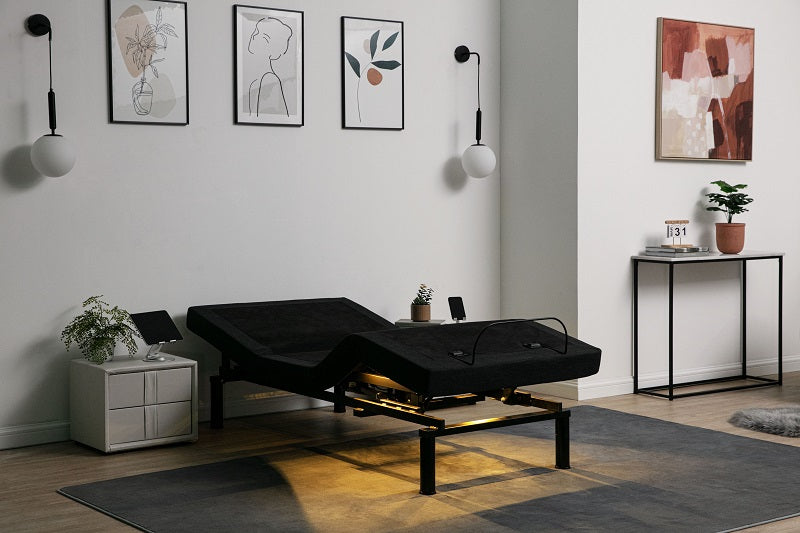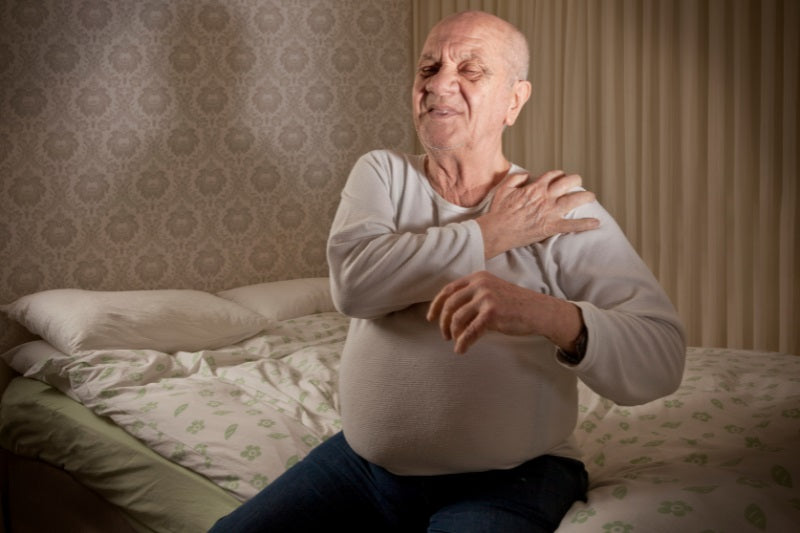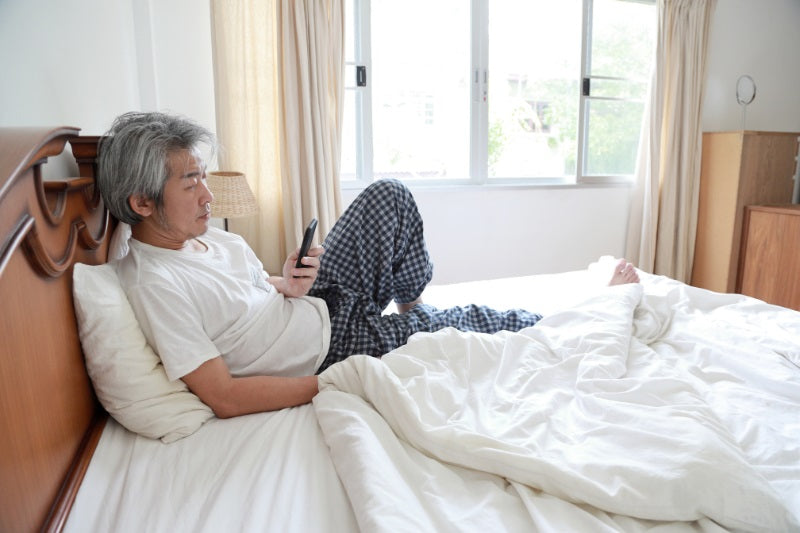Aging in place is the term used to describe the preference of many older adults to remain in their own homes and communities as they age. However, aging in place can pose some challenges, especially when it comes to the bedroom. The bedroom is one of the most important rooms in the house, as it is where we spend about a third of our lives sleeping, resting, and relaxing. For elderly individuals, the bedroom can also be a source of discomfort, safety risks, and mobility limitations due to age-related sleep issues, health conditions, and physical changes.
Fortunately, some solutions can help elderly individuals enjoy their bedrooms and improve their quality of life. One of these solutions is an adjustable bed, which is a bed that can be adjusted to different positions and angles using a remote control or a smartphone app. In this article, we will explore how adjustable beds can facilitate independent living for elderly individuals by providing them with more control, comfort, and convenience in their bedroom.

Enhancing Bedroom Accessibility
One of the main challenges elderly individuals face when aging in place is maintaining their independent mobility, which is the ability to move around without assistance or dependence on others. Independent mobility is essential for daily activities, such as getting in and out of bed, dressing, grooming, and accessing personal items. However, as people age, they may experience reduced strength, balance, flexibility, and coordination, making these tasks more difficult and increasing the risk of falls and injuries.

To enhance bedroom accessibility and promote independent mobility, seniors can use adjustable beds as their mobility solutions. Indeed, adjustable beds can provide several accessibility features that can make the bedroom more user-friendly and adaptive, such as:
- Height adjustment: Electric beds can be raised or lowered with the help of adjustable legs to suit the individual's preference and needs This can make it easier to get in and out of bed and reach the floor, the nightstand, or other furniture in the bedroom.
- Head and foot elevation: The elevation of head and leg sections can help with positioning, posture, and comfort, as well as with accessing pillows, blankets, books, or other items on the bed.
- Massage and vibration: Some adjustable beds have built-in massage and vibration features that can provide soothing and relaxing sensations to the body. These functionalities can help relieve stress, tension, and pain, as well as stimulate blood flow and circulation.
By using these features, elderly individuals can customize their beds to their liking and needs and enjoy more independence and convenience in their bedrooms.

Comfort and Safety for Elderly Individuals
Another challenge elderly individuals face when aging in place is ensuring their comfort and safety in the bedroom. There are important factors for maintaining health, well-being, and quality of life, as they can affect the physical, mental, and emotional aspects of the individual. However, comfort and safety can be compromised by various factors, such as health conditions, environmental hazards, and age-related sleep issues, which can cause discomfort, pain, anxiety, and fear. Here are some adjustable bed benefits that can enhance comfort and safety in the bedroom:
Pressure relief
Adjustable beds can help relieve pressure points and distribute body weight evenly on the mattress. This can help with preventing and alleviating pressure ulcers, which are skin injuries that can occur due to prolonged pressure on specific areas of the body, such as the hips, heels, and elbows. Pressure ulcers can cause pain, infection, and reduced mobility, and can affect the quality of life of elderly individuals.
Temperature regulation
By allowing air circulation and ventilation under and around the mattress, adjustable beds can also help with regulating the temperature and optimizing humidity of the sleeping environment. Temperature regulation is critical in preventing and reducing overheating, sweating, and dehydration, which can cause discomfort, irritation, and sleep disturbances. It also helps with managing some health conditions, such as diabetes, arthritis, and menopause, which can affect the body's ability to regulate its temperature.
Fall prevention
Falls are one of the leading causes of injury and death among elderly individuals and can have serious consequences for their health and well-being. Using adjustable beds can assist in preventing falls and injuries in the bedroom by providing stability, support, and assistance to the individual. For example, adjustable frames can help with getting in and out of bed safely by adjusting the height and angle of the mattress to the optimal level.
Addressing Age-Related Sleep Challenges
A third challenge elderly individuals face when aging in place is coping with age-related sleep issues. Sleep is essential for health, well-being, and overall quality of life, as it plays a vital role in repairing and restoring the body and the brain, and regulating metabolism, immunity, memory, and mood. Sadly, as people age, they may experience changes in their sleep quality and quantity due to hormonal changes, circadian rhythm disruptions, medication side effects, or other conditions. That said, adjustable beds may become part of sleep improvement strategies, helping optimize and customize sleep, and establish sleep routines suitable for a particular individual.

Firstly, electric frames allow the adjustment of the head and foot sections of the mattress to the preferred angle and elevation, improving breathing, digestion, and circulation and reducing snoring, acid reflux, and swelling.
Secondly, adjustable beds can help with customizing the sleep comfort and preference of the individual by allowing them to choose the firmness, softness, and support of the mattress, as well as the temperature, humidity, and lighting of the sleeping environment.
Finally, adjustable frames can assist with establishing a regular and consistent sleep routine. For example, elderly users can use a remote control or a smartphone app to set and adjust their bed settings easily and quickly, as well as to save and recall their favorite settings for future use.
All that will help with creating a habit and a ritual of preparing for bed and waking up, contributing to improving the sleep cycle and the circadian rhythm and promoting restful sleep.
Managing Mobility Limitations
One more challenge of independent living for seniors is dealing with mobility limitations. Mobility is the ability to move freely and easily, and it is essential for performing daily activities. However, when aging, people may experience reduced mobility caused by muscle loss, joint pain, bone density loss, and balance impairment, which can affect their physical function and performance.
Adjustable beds can be used as part of their assistive devices and mobility aid solutions.
For instance, electric frames can help with relieving muscle and joint pain and stiffness, improving the range of motion, flexibility, and coordination of the individual, and reducing inflammation, and swelling. These smart beds also promote bone and spine health, preventing spinal deformities, such as kyphosis and scoliosis, and reducing the risk of osteoporosis and fractures, which certainly make a huge health impact.

Health Benefits of Adjustable Beds
In the context of independent living for elderly people, perhaps the most significant health benefits that adjustable beds deliver are:
- Improved circulation: Adjustable beds can enhance blood circulation and oxygen delivery to the body and the brain by allowing the individual to adjust the head and foot sections of the mattress to different angles. For example, a so-called zero gravity position, with the head and legs slightly elevated above the heart level, helps improve heart function and promote better blood flow in the legs, preventing and treating some circulatory problems, such as varicose veins, edema, and leg cramps.
- Enhanced respiratory function: Elevating the head section enhances respiratory function and breathing capacity by opening the airways, clearing the nasal passages, and reducing the pressure on the chest and lungs. Also, changing the tilt of the head section by several degrees only helps mitigate snoring and cope with some respiratory problems, such as asthma, allergies, and sleep apnea.
- Reduced pain and inflammation: Massage and vibration features of adjustable beds help relax and soothe the muscles, joints, and nerves, helping with reducing pain and inflammation in the body and alleviating some pain-related problems - arthritis, fibromyalgia, sciatica, and back pain.
FAQ
What are the advantages provided by adjustable beds for the elderly?
Adjustable beds offer personalized comfort, ease of getting in and out of bed, relief from common problems like arthritis and back pain, and improved circulation for better overall health.
How do adjustable beds enhance the quality of life and independence for elderly individuals?
Adjustable beds enable elderly individuals to customize sleeping positions, alleviate pain, and independently control bed height. This promotes better sleep, reduces dependency on caregivers, and enhances overall well-being.
How do I choose the right adjustable bed for the elderly?
Consider factors such as ease of use, range of motion, mattress type, safety features, and budget. Opt for beds with user-friendly controls, sufficient adjustability, and features that address specific health needs, ensuring comfort and safety for the elderly.
A Final Word
Aging in place is a desirable option for many elderly individuals, as it allows them to remain in their own homes and communities and maintain their independence, dignity, and quality of life. However, this choice can also present some challenges, especially when it comes to the bedroom, which is, being one of the most important rooms in the house, can also be a source of discomfort, safety risks, and mobility limitations due to age-related sleep issues, health conditions, and physical changes.
Due to their rich functionality, adjustable beds can greatly enhance bedroom comfort and safety, address age-related sleep challenges, manage mobility limitations, and improve health and well-being. If you’re considering purchasing an adjustable bed for you or your loved ones, read more in detail about the benefits of adjustable beds and reach out to our support team to choose the best bed that fits your needs.
sales@progressivebed.com | 1-800-828-9381
